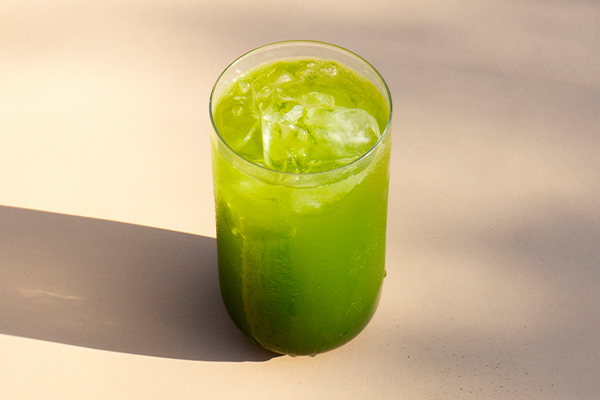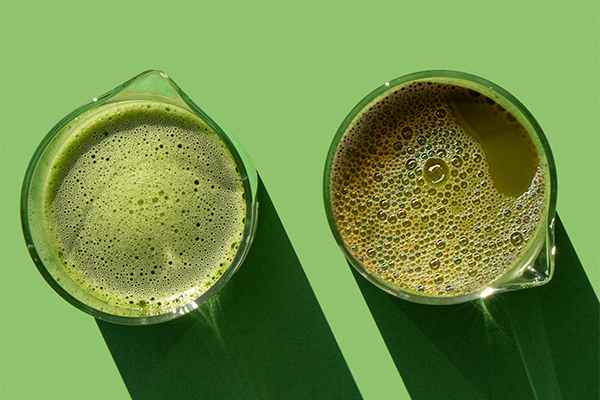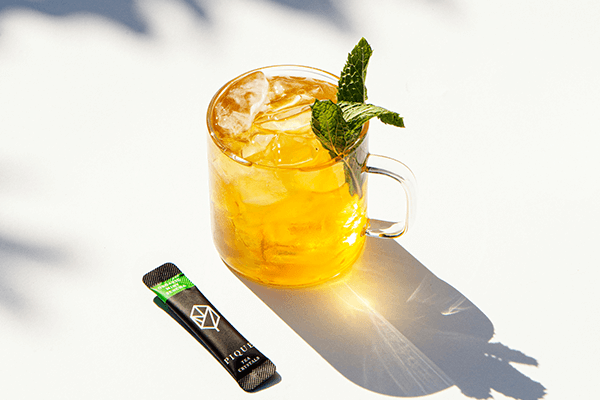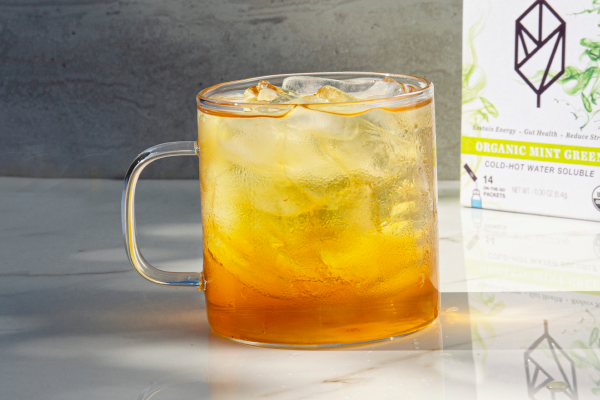You’ve probably heard about the many health benefits of green tea. This little leaf is known for its big antioxidant content and ability to provide steady, even energy.
But you may be wondering if you can maximize these benefits by switching to its cousin, matcha. And what is the difference between the two, really?
Here, we’ll break down the key differences and similarities between these two popular forms of green tea.
-
Processing
Both matcha and green tea begin as the camellia sinensis plant — also the origin of black, oolong and white tea. But depending on whether its leaves are destined for matcha or green tea, the plant is grown and processed differently.
Tea plants that will become matcha are grown in the shade, which boosts its chlorophyll content. This gives matcha powder its distinct, vibrant green color.
Once harvested, the leaves are steamed to stop oxidation and then dried. The minimal oxidation is what gives all varieties of green tea its bitter, grassy flavor. With oxidized tea like black and oolong, the astringency gives way to a roasty, slightly sweeter flavor profile.
This is where the process ends for regular green tea. The dried leaves are broken up for tea bags or carefully packaged as loose leaf tea, ready to steep.
To make matcha, there’s one extra step — the bright green dried leaves are pulverized into a fine powder.
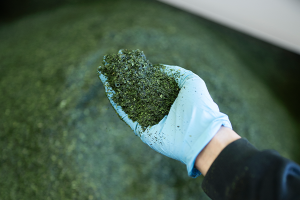
-
Preparation
Preparing matcha takes a bit more time and effort than regular green tea.
Brewing up a cup of green tea is as simple as steeping leaves in boiling water for a few minutes. The tea drinker simply has to decide how bitter they want their drink to be. Longer steeping times will draw out more of the natural tannins in green tea, resulting in a sharper taste. Steeping for just two to three minutes, on the other hand, will produce a gentler flavor.
Making matcha correctly requires more tools and a bit more finesse. First, you’ll want to make sure you’re using ceremonial grade matcha for beverages — the kind used in Japanese tea ceremonies. Matcha has become a popular additive to smoothies and baked goods, but those recipes typically use culinary grade matcha — a lower quality powder not meant for straight matcha drinking.
You’ll also want to watch your water more closely. Because matcha is meant to be whisked up and consumed right away — not steeped for several minutes — it’s best not to bring your pot to a boil. Instead, bring your water to a temperature you can drink comfortably.
Once the water is ready, pour a few tablespoons into your mug with about a teaspoon of matcha powder, and whisk this up until it forms a paste. This will make it easier to distribute the matcha evenly when you add the rest of your water — another six ounces or so.
And about that whisk…. Traditionally, a bamboo whisk is used because its close-knit but flexible fibers do a thorough job getting into the corners of the cup and produce an even mixture. If you don’t have one of these, a small wire whisk will do just fine… just make sure you scrape up any powder that may have stuck to the bottom of your mug.
Also remember that matcha is a suspension, not a solution. If it sits too long, the powder will settle. This is why matcha is usually served in small portions, so it can be drunk quickly.
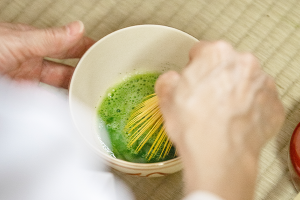
-
Taste
The word “grassy” is often used to describe the taste of green tea. That goes back to the lack of fermentation. Green tea also has a bitter taste, thanks to its tannins. The longer the brew time and hotter the water, the more tannins get released.
Matcha shares some of those qualities. It has a grassy, vegetal quality, but not as much bitterness. In fact, high quality matcha powder has a subtle sweetness to it.
Of course, this applies to traditional matcha, which is drunk without the addition of any milk or sweetener. Today, matcha is commonly consumed in latte form. Lattes tend to be deceptively high in fat and sugar. A grande Starbucks matcha latte, for example, packs in 4.5 grams of saturated fat and 32 grams of sugar.
While fine as an occasional treat, these extras can offset some of matcha’s health benefits. Which brings us to our next topic.
-
Antioxidant Content
Both matcha and green tea deliver a high dose of the catechin epigallocatechin-3-gallate (EGCG) – a powerful antioxidant. But there is a distinction. Because matcha powder consists of the whole tea leaf — not just its infusion in hot water — it contains at least three times the concentration of antioxidants found in green tea. [1]
However, that’s not to say that green tea is a slouch on the antioxidant front. It still delivers enough ECGC to confer multiple health benefits.
As their name implies, antioxidants combat oxidative stress by neutralizing free radicals, which are a byproduct of normal cell metabolism. Researchers have cited a May 2016 British Journal of Nutrition study which found that foods high in antioxidants — including green tea — can reduce markers of inflammation in the body. Because inflammation can contribute to overall unwellness, an antioxidant-rich diet is just one tool that may help support your vitality and healthy aging. [2][3]
Researchers have also found a tenuous link between ECGC and weight management. One study found that men who consumed 300mg of ECGC over two days experienced supported thermogenesis, or calorie burn. [4]
However, a review of several brands of green tea found that an average cup contained anywhere from 25 to 86 mg of ECGC. You’d have to drink at least 4 cups to hit the antioxidant dosage administered in this study.
This is where matcha’s higher concentration of catechins might provide a bit of an edge — but keep in mind that no variety of green tea on its own is a silver bullet for weight loss. The study simply suggests that regular consumption of ECGC could help to support healthy weight management.
Ultimately, both matcha powder and green tea provide a healthy dose of antioxidants. Choose the variety that you most enjoy and are more likely to drink on a regular basis.
-
Caffeine Content
Similar to antioxidant content, matcha contains more caffeine because it consists of the entire green tea leaf. A standard cup of green tea contains roughly 28mg of caffeine, compared to 70 to 140 mg found in a cup of matcha. [5]
Both forms of green tea, however, contain the amino acid L-theanine, which has calming properties that even out the effects of caffeine. The result is a steady and sustained energy, without the jitteriness and subsequent crash that can come with other caffeine-containing beverages like coffee.
Still, you may want to avoid both matcha and green tea before bedtime to ensure undisrupted sleep.
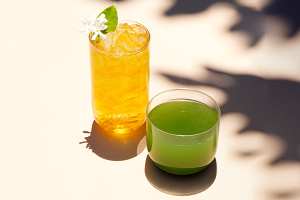
Which is Better, Green Tea or Matcha?
Matcha and green tea may differ in their taste, method of preparation, antioxidant and caffeine content, but both confer health benefits and a feeling of clam energy.
It’s not a question of which is better, but which one you prefer, and are more likely to drink on a daily basis!
